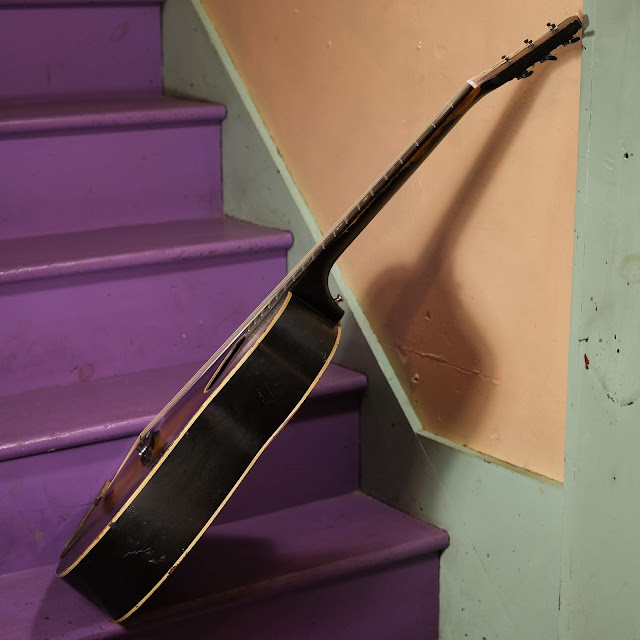1935 Harmony-made 000-Size Round-hole Archtop Guitar
A customer sent this birch-bodied, funk-tastic Harmony build in a while back. He was hunting something for "open-tuned, bluesy, slide stuff." It didn't have to be wonderful, but it had to be practical. I'd say having an adjustable-height bridge on an archtop that wants to be a flattop fits that bill, though.
It has an F-35 (made in '35) stamp on the inside and an illegible Harmony model number, but this guitar is one of half a dozen of this same basic type I've worked-on in the past. Some have spruce tops, some have birch, some are flattops with tailpieces (a lot of the "Vagabond" 000-size Harmony-makes are that version of this guitar), some are archtops with failed bracing patterns. This one is the latter -- it was press-arched into a round-hole archtop guitar shape and then braced with what I call "strapping" braces in a ladder-braced fashion.
These "strapping" braces are basically top-material 1/8"-thin spruce cut into 1/2" or 3/4" wide sections and clamped to fit the new arch of the top. They just bend to fit it because they're so thin. I use this technique to replace missing braces on guitar backs where the back has deformed over time and it's an irritant (and wasted effort) to spend hours fitting proper braces to whatever odd curve is back there, but it's not the greatest top-bracing idea.
In evidence of this theory -- every one of these with these "strapping-brace" patterns has a collapsed top. The arch is almost gone and the instrument reverts to a "wavy" shape -- like a flattop that's gotten a little confused and hilly.
However, if you've ever heard one of these guys fixed-up and stabilized-to-play and with this original bracing in place -- you can immediately hear just how awesome they sound. This thing is absurdly-loud, punchy, woody, and barky and I had to back the mic off a bunch so it wouldn't clip the recording. It has a banjo-like or resonator-like attack but with a woody/warm vibe. It should be perfect for clanking-out country-blues.
Repairs included: a neck reset via internal bolt, new bone nut, seam repairs to the top/back, one long crack repair/cleats to the top, a fret level/dress, side dots install, new (parts-bin-salvage) adjustable rosewood bridge, and setup.
Setup notes: it plays perfectly with 3/32" EA and 1/16" DGBE action at the 12th fret, has a straight neck, and is strung with 52w-11 gauges.
Scale length: 25 1/8"
Nut width: 1 3/4"
String spacing at nut: 1 7/16"
String spacing at bridge: 2 1/8"
Body length: 18 7/8"
Lower bout width: 15 1/4"
Waist width: 9 7/8"
Upper bout width: 11"
Side depth at endpin: 3 5/8"
Top wood: solid birch
Back/sides wood: solid birch
Neck wood: poplar
Bracing type: ladder strapping-braces
Fretboard: ebonized maple/pearwood, new bone nut
Bridge: rosewood adjustable, '70s-era, recut
Neck feel: big C-shape, flat board
Condition notes: it's all funky, but also all-original except for the bridge and nut. There's a repaired top crack on the lower bout that runs from the tailpiece area to the bridge. There's also some slightly-misaligned back/side seams. The fretboard has chip-out near the frets from the 12th fret onwards, but I've reseated all the frets and glued them in place so they're good to go (these ebonized old fretboards tend to get a bit mealy and chip-out as they dry-out). The top has distortion/waviness from its arch collapsing more to a flattened shape. It's stable, though -- the guitar has remained the same for the last few days with no setup adjustments needed. Besides -- the bridge is adjustable! There's also wear and tear throughout the finish, with lots of smaller scratches, nicks, and dings. The original tuners are not great, but as long as you follow the old rule of "tune UP to pitch but never DOWN to pitch," they will hold.



















Comments